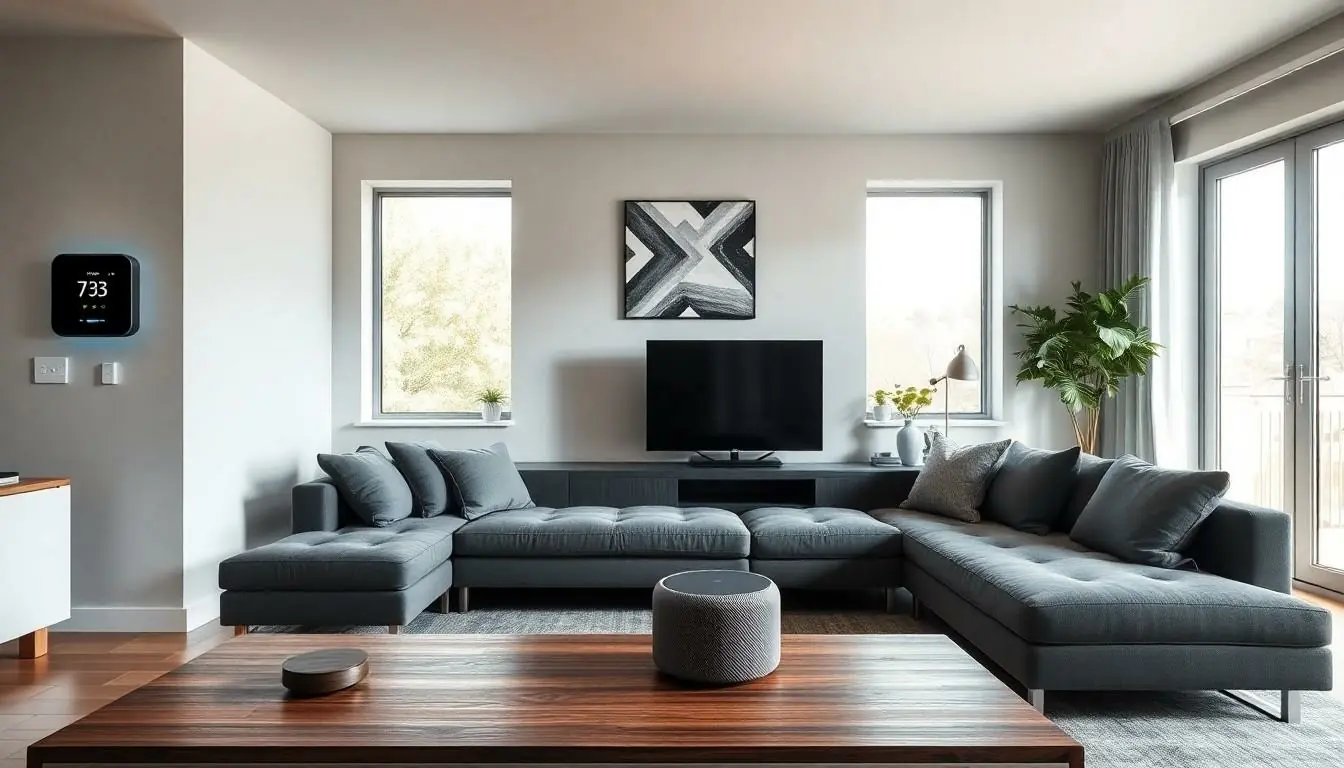Table of Contents
ToggleIn a world where your fridge can tell you when you’re out of milk and your lights can dim with a simple voice command, smart home adoption isn’t just a trend; it’s a lifestyle upgrade. Imagine strolling into your living room and having the curtains draw themselves while your favorite playlist kicks in. Sounds like the future, right? Well, welcome to 2023, where that future is knocking on your door—literally!
As technology evolves, so does the way people live. Smart homes are no longer reserved for tech-savvy millionaires. They’re becoming accessible and affordable for everyone. With a sprinkle of convenience and a dash of fun, adopting smart home tech can transform mundane chores into effortless tasks. So why not embrace the era of automation? After all, who wouldn’t want a home that practically runs itself?
Overview of Smart Home Adoption
Smart home adoption reflects a significant shift in consumer behavior, with an increasing number of households implementing smart technology. Reports indicate that the global smart home market reached a valuation of approximately $80 billion in 2022 and is projected to expand at a compound annual growth rate of 25 percent through 2030. Such statistics underline the rapid acceptance of connected devices in everyday living.
In 2023, more consumers view smart devices as essential rather than luxury items. Security cameras, smart speakers, and automated lighting systems lead the adoption wave. These devices not only enhance convenience but also improve energy efficiency and home security.
Demographic trends identify younger generations as primary adopters. Millennials and Gen Z tend to embrace technological advancements, often seeking innovative solutions to streamline daily activities. As technology costs decrease, older demographics are also integrating smart home elements, finding value in improved quality of life.
Key benefits drive smart home adoption. Enhanced convenience simplifies tasks such as controlling home appliances remotely. Improved security features add a layer of safety for families. Data shows that users experience energy savings of up to 30 percent by integrating smart energy management systems.
Challenges still exist, despite positive trends in adoption. Concerns about privacy and data security create hesitation among potential users. Education on smart technology and its benefits plays a pivotal role in alleviating fears and encouraging more widespread implementation.
Overall, smart home adoption demonstrates a clear trajectory toward mainstream integration. The growing availability of user-friendly devices and robust support networks contributes to this trend. Enhanced connectivity and landscape of IoT devices shape the future of smart living.
Benefits of Smart Home Technology

Smart home technology presents several significant advantages that enhance daily living. These benefits encompass convenience, energy efficiency, and enhanced security.
Convenience and Automation
Smart home devices streamline everyday tasks, allowing individuals to control various functions from a single interface. Voice-activated assistants enable quick adjustments to lighting, temperature, and entertainment systems. Remote access through smartphones offers flexibility, making it easy to manage home settings while away. Scheduling options automate repetitive tasks, such as adjusting thermostats or starting coffee machines. Increased convenience leads to a more enjoyable living experience.
Energy Efficiency
Energy management systems contribute to considerable cost savings by optimizing energy use. Smart thermostats learn patterns, adjusting heating and cooling based on occupancy and preferences. Automated lighting systems turn off when rooms are unoccupied, reducing waste. Reports indicate energy savings of up to 30 percent, significantly impacting monthly utility bills. Moreover, smart appliances operate during off-peak hours, further enhancing overall energy efficiency.
Enhanced Security
Security cameras and smart locks provide advanced measures to protect homes. Real-time alerts notify homeowners of unusual activity or breaches, allowing for immediate action. Remote surveillance features enable monitoring from anywhere, ensuring peace of mind. Integration with alarm systems enhances safety by increasing response times during emergencies. Many systems offer two-way audio and video, allowing for direct communication with visitors at the door. These features collectively foster a secure living environment, giving residents confidence in their home safety.
Challenges in Smart Home Adoption
Smart home adoption faces key challenges that can hinder its growth. Addressing these issues is crucial for consumers and manufacturers alike.
Privacy Concerns
Privacy concerns remain a significant barrier to smart home adoption. Consumers often worry about personal data collected by devices. Smart devices frequently gather information to enhance functionality, leading to fears of unauthorized access. Educating users on data encryption and secure protocols can help mitigate these concerns. Many manufacturers are increasing transparency regarding data usage, showcasing their commitment to privacy. Establishing trust plays a vital role in boosting consumer confidence in smart technology.
Compatibility Issues
Compatibility issues also present challenges in creating seamless smart home ecosystems. Many devices come from different manufacturers, causing integration problems. Lack of standardization across brands can lead to frustration when attempting to connect various devices. Homeowners may find that not all products communicate effectively, limiting their smart home experience. As the market evolves, manufacturers are increasingly developing solutions that prioritize compatibility. Embracing open-source platforms enhances integration, allowing consumers to select devices that work together efficiently.
Market Trends and Statistics
The smart home market shows significant growth, reflecting increased consumer adoption and technological advancements. Valued at approximately $80 billion in 2022, projections indicate a compound annual growth rate of 25 percent through 2030. Market analysis reveals that younger generations, especially Millennials and Gen Z, lead the charge in smart home integration. Older demographics also adopt smart technologies, driven by decreasing costs and enhanced functionalities.
Growth of Smart Home Market
Smart home adoption continues to expand rapidly. The annual growth rate reflects how consumers increasingly value convenience and security. By 2030, the market’s total value could exceed $600 billion, driven by innovations in automation technology. Moreover, global events and the recent shift towards remote work have accelerated the need for smart solutions. Retailers report consistent increase in sales of smart devices, indicating a rising trend towards permanent integration.
Popular Smart Home Devices
Smart speakers remain among the top devices in households, with nearly 60 percent of owners utilizing them for various tasks. Security cameras also rank high, providing homeowners with crucial peace of mind through real-time monitoring. Automated lighting systems enhance efficiency and aesthetic appeal, contributing to overall energy savings. Smart thermostats help users manage heating and cooling, potentially reducing energy consumption by up to 30 percent. In addition, devices like smart plugs and door locks increase home automation, reflecting users’ desire for seamless interactions.
Future of Smart Home Adoption
Smart home adoption continues to evolve rapidly. Advancements in technology will drive substantial changes in how people interact with their living environments.
Innovations on the Horizon
Innovations in artificial intelligence are set to revolutionize smart home functionality. More intuitive devices will emerge, allowing seamless integration of home systems. Voice recognition technology is becoming increasingly sophisticated, enabling users to control appliances with simple commands. Additionally, developments in machine learning will optimize energy consumption by predicting usage patterns. Companies are investing in enhanced security measures that protect user data and improve trust in smart systems. Smart home devices will likely feature advanced environmental sensors, enabling better air quality management and energy efficiency. Novel applications will foster a more integrated lifestyle, leading to greater overall satisfaction for users.
Predictions for Market Growth
Market growth projections indicate an exciting future for smart home technology. Analysts anticipate the global market will surpass $600 billion by 2030. Customer demand will drive a compound annual growth rate of around 25 percent. Younger generations are expected to remain primary adopters, while older demographics increasingly embrace smart devices. Urban areas will likely see higher adoption rates as tech-savvy consumers seek convenience. The proliferation of affordable smart products will further expand accessibility, allowing more households to integrate these technologies. In summary, steady growth in the smart home sector will reflect ongoing innovation and improvements in user experience, shaping modern living.
Smart home adoption is rapidly reshaping how individuals interact with their living spaces. As technology becomes more accessible and affordable, the benefits of enhanced convenience and energy efficiency are drawing in a diverse range of consumers. Younger generations lead the charge but older demographics are also embracing these innovations.
While challenges like privacy concerns and device compatibility persist, manufacturers are actively working to address these issues. The future looks promising with advancements in AI and machine learning poised to elevate smart home functionality. As the market continues to evolve, the integration of smart technology into daily life is set to become the norm, paving the way for a more connected and efficient lifestyle.




